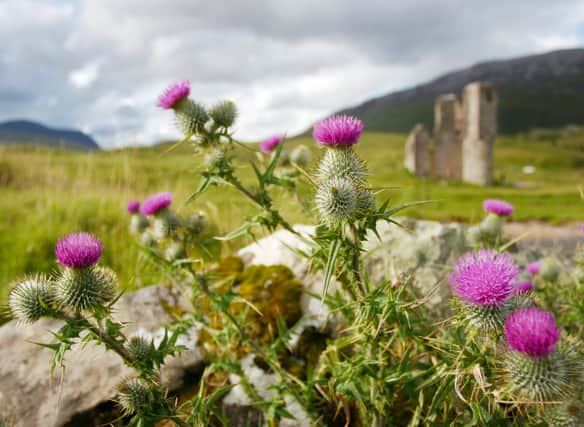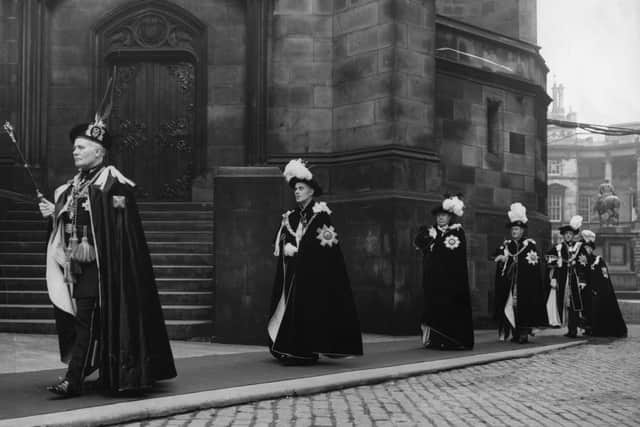Scotland’s National Flower - The Thistle: Why is the thistle a national emblem of Scotland?
England has a rose, Wales a daffodil, Ireland a shamrock and Scotland the purple, prickly but proud thistle which has been our national emblem for centuries, here’s why.


The national flower of Scotland is the thistle and it is one of our most recognisable symbols. During summer, this group of prickly plants becomes more noticeable and it is no surprise as they can grow up to eight feet tall according to Highland Titles.
With savage spines that guard it from predation and drought-resistance as powerful perennials, the enduring legacy of the Scottish thistle adds much to its allure. The story as to how it became the national flower of Scotland, however, runs deeper than just its superficial qualities as the plant was reportedly involved in a major Scottish battle that forever changed the country thereafter.
Advertisement
Hide AdAdvertisement
Hide AdHere is an overview of the history that underpins the Scottish thistle and why it remains such an important symbol of our heritage plus a few interesting facts about the flower itself.


History of the Scottish Thistle
According to the National Trust for Scotland: “Silver coins in Scotland and later Britain have long featured a thistle, and the first coins to do so were as early as 1474, issued by King James III in Scotland.”
King James VII and II founded the Order of the Thistle in 1687 i.e., “the greatest order of chivalry in Scotland” as the Royal Family explains. Their heraldic emblem was the thistle along with the motto “Nemo me impune lacessit” which means “no one provokes me with impunity” - a reference to the thistle itself that cannot be attacked without its assailant being pricked by it.
However, many believe that the Order of the Thistle relates to a more ancient order that dates back to Emperor Charlemagne in the 9th century. The National Records of Scotland reports that “Mary Queen of Scots (1542-1587) had the thistle’s image incorporated into the Great Seal of Scotland, making it a national symbol for longevity.”
Nowadays, the symbol can be found all throughout the country including in the Police Scotland, Scottish Rugby and Scottish national football team logos.
Why is the thistle the Scottish national flower?
There are a few theories as to why the thistle is Scotland’s national flower, but the most widely accepted reason pertains to the Battle of Largs in 1263. Many forget that, hundreds of years ago, Scotland was ruled as part of the Kingdom of Norway.
In 1263, however, everything changed after King Alexander III proposed to purchase the Western Isles and Kintyre from Nordic King Haakon IV. That summer, the Norse King set his sights on Scotland in response to Alexander’s bid to liberate the nation, and set off with a fleet of longships towards the beach at Largs in Ayrshire.
The legend goes that during this invasion the Norsemen attempted to surprise the Scots by stealthily moving in on their territory while they slept in order to execute a sneak attack. They removed their shoes so as to do so more quietly. However, thanks to our friend the trusty thistle, one man crept onto the prickly plant and yelped out in pain.
Advertisement
Hide AdAdvertisement
Hide AdThis alerted the Scottish clansmen to the enemy’s presence which thus saved them from the swift death that awaited them. The thistle has been recognised as a national emblem of Scotland ever since.
What type of thistle is the national emblem?
As the Scotland Grows Magazine explains: “It may surprise you to know that Scotland is home to several varieties of thistle.
“The plant we know as the Scotch thistle, Onopordum acanthium, also known as the cotton thistle, is not native and was most likely introduced from Europe pre-16th century.
“It was chosen by Sir Walter Scott (1771-1832) as the emblem for George IV’s visit to Scotland in 1822.”
Many sources agree that the ‘true’ thistle of Scotland is the Cirsium vulgare or spear thistle which is also referred to as the bank or common thistle. It is the most similar to how the plant was depicted on antique Scottish coins.
The name “Cirsium” is said to come from the Greek “kirsos” which is a swollen vein. This is likely due to the plant’s medicinal properties as it was used to remedy swollen veins.
Comments
Want to join the conversation? Please or to comment on this article.
